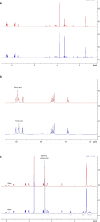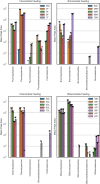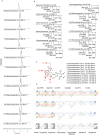Biosynthesis of natural and halogenated plant monoterpene indole alkaloids in yeast
- PMID: 37932529
- PMCID: PMC10667104
- DOI: 10.1038/s41589-023-01430-2
Biosynthesis of natural and halogenated plant monoterpene indole alkaloids in yeast
Abstract
Monoterpenoid indole alkaloids (MIAs) represent a large class of plant natural products with marketed pharmaceutical activities against a wide range of indications, including cancer, malaria and hypertension. Halogenated MIAs have shown improved pharmaceutical properties; however, synthesis of new-to-nature halogenated MIAs remains a challenge. Here we demonstrate a platform for de novo biosynthesis of two MIAs, serpentine and alstonine, in baker's yeast Saccharomyces cerevisiae and deploy it to systematically explore the biocatalytic potential of refactored MIA pathways for the production of halogenated MIAs. From this, we demonstrate conversion of individual haloindole derivatives to a total of 19 different new-to-nature haloserpentine and haloalstonine analogs. Furthermore, by process optimization and heterologous expression of a modified halogenase in the microbial MIA platform, we document de novo halogenation and biosynthesis of chloroalstonine. Together, this study highlights a microbial platform for enzymatic exploration and production of complex natural and new-to-nature MIAs with therapeutic potential.
© 2023. The Author(s).
Conflict of interest statement
J.D.K., J.Z., L.G.H., S.A.B. and M.K.J. are inventors on pending patent applications (patent applicant: Technical University of Denmark; application number: PCT/EP2023/063481). L.G.H., J.Z., J.D.K. and M.K.J. have financial interests in Biomia. J.D.K. also has financial interests in Amyris, Lygos, Demetrix, Napigen, Apertor Pharmaceuticals, Maple Bio, Ansa Biotechnologies, Berkeley Yeast and Zero Acre Farms. All other authors have no competing interests.
Figures















References
Publication types
MeSH terms
Substances
Grants and funding
- 814645/EC | Horizon 2020 Framework Programme (EU Framework Programme for Research and Innovation H2020)
- NNF20CC0035580/Novo Nordisk Fonden (Novo Nordisk Foundation)
- NNF19SA0035438/Novo Nordisk Fonden (Novo Nordisk Foundation)
- DNRF137/Danmarks Grundforskningsfond (Danish National Research Foundation)
LinkOut - more resources
Full Text Sources
Molecular Biology Databases

